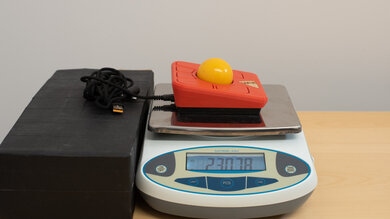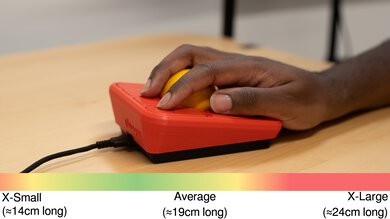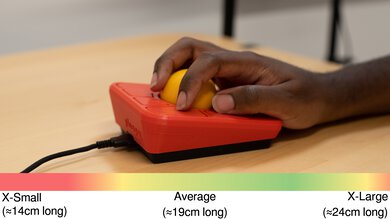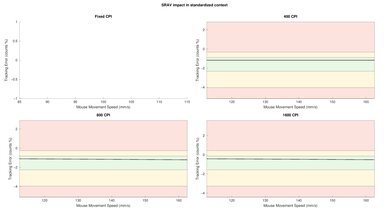The Ploopy Adept Trackball is a finger-operated trackball mouse that you can buy as a prebuilt or 'do-it-yourself' kit. It uses a PixArt PMW3360 sensor (a high-performance flagship sensor used on previous-generation gaming mice) and ball bearings that allow the trackball to roll in its housing. This trackball is an open-source project with all design and production files available on GitHub, and it uses VIA software and QMK firmware for configuration.
Our Verdict
The Ploopy Adept has a comfortable finger-operated shape with a distinct DIY look and design approach. It uses 3D-printed plastic parts, some of which may have small imperfections and a rougher finish. However, the overall build feels very sturdy, and the fit and finish are good. While it lacks a dedicated scroll wheel, it uses a drag scroll feature that requires you to hold a button and use the ball to scroll. This scrolling technique is very precise, and you can intuitively control scrolling speed. That said, it may take some getting used to and can slow your workflow somewhat as you can't scroll and move your cursor at the same time. Using the VIA configuration software, you can reprogram all buttons and change other settings. For more advanced customization, you can flash custom firmware using QMK. This is a wired-only trackball, so it isn't well-suited for multi-device setups.
-
Supports VIA software and QMK firmware for in-depth customization.
-
Acceptable build quality.
-
While they're quite accurate and smooth, its ball bearings are noisier than the static bearings commonly found on other trackballs.
-
Somewhat rough 3D printed case design with visible printing imperfections.
Though not designed explicitly for FPS gaming, the Ploopy Adept is more than performant enough for playing FPS titles at any competitive level. It may take some time to get used to if you normally use a conventional mouse. Due to the limitations of our methodology (primarily designed to test conventional mice), we can't evaluate the sensor latency. However, it uses a reliable flagship gaming sensor we've tested in other mice. For more details, see the Sensor Latency section. Also note that this trackball uses click-and-drag scrolling since it doesn't have a dedicated scroll wheel, which may be relevant if your playstyle depends heavily on scroll wheel binds. Lastly, it's worth pointing out that as a stationary trackball, its weight doesn't matter. However, the ball itself is lightweight, and while it makes noise moving in its housing, it feels very quick and consistent in-game.
-
Impressive click latency.
-
1000Hz polling rate, which is rare for trackball mice.
-
Supports VIA software and QMK firmware for in-depth customization.
-
Acceptable build quality.
-
While they're quite accurate and smooth, its ball bearings are noisier than the static bearings commonly found on other trackballs.
-
Somewhat rough 3D printed case design with visible printing imperfections.
The Ploopy Adept isn't designed specifically for MMO gaming, but it has six buttons, all of which you can reprogram using VIA configuration software. It also has impressive click latency and acceptable overall build quality, though the materials are somewhat rougher and have a clear DIY aesthetic compared to dedicated MMO gaming mice. Lastly, it uses a drag scroll since it doesn't have a dedicated scroll wheel, which can be an issue if you rely heavily on a scroll wheel for your play style.
-
Impressive click latency.
-
Supports VIA software and QMK firmware for in-depth customization.
-
Acceptable build quality.
-
While they're quite accurate and smooth, its ball bearings are noisier than the static bearings commonly found on other trackballs.
-
Somewhat rough 3D printed case design with visible printing imperfections.
The Ploopy Adept delivers superb raw performance. It's suitable for playing games at any competitive level. It has excellent click latency and a 1000Hz polling rate, which is rare for trackballs, and helps, in part, to maintain consistent low latency performance. We can't test the sensor latency using our current test methodology, which is primarily geared toward testing conventional mice. However, its sensor model, PixArt PMW3360, is a previous-generation gaming sensor with an excellent performance record. For more details, see the Sensor Latency section.
-
Impressive click latency.
-
1000Hz polling rate, which is rare for trackball mice.
- 5.9 Work
- 6.8 Video Games (FPS)
- 7.4 Video Games (MMO)
- 9.3 Raw Performance
Changelog
- Updated Jul 24, 2024: Review published.
- Updated Jul 08, 2024: Early access published.
- Updated Jun 26, 2024: Our testers have started testing this product.
- Updated Jun 11, 2024: The product has arrived in our lab, and our testers will start evaluating it soon.
- Updated May 27, 2024: We've purchased the product and are waiting for it to arrive in our lab.
Check Price
Differences Between Sizes And Variants
The Ploopy Adept Trackball is available in several colorway options, either as a prebuilt or DIY kit configuration that you need to build yourself. We bought and tested a prebuilt model in the red colorway with a yellow ball.
| Configuration | Top Color Options | Ball Color Options | Notes |
|---|---|---|---|
| Ploopy Adept (Fully Assembled) | Black, Red, Blue, Purple, Yellow | Red, Yellow, Brown | Fully prebuilt, no assembly required |
| Ploopy Adept (Full Kit) | Black, Red, Blue, Purple, Yellow | Red, Yellow, Brown | Includes all necessary components but needs assembly |
| Ploopy Adept (Print-it-Yourself) | N/A | Red, Yellow, Brown | Includes all internal components + ball but requires you to 3D-print plastic parts and needs assembly |
Compared To Other Mice
The Ploopy Adept Trackball is a wired, finger-operated trackball with a distinct 'do-it-yourself' design approach. It uses 3D printed parts and is a fully open-source project, with all its design files available online. It also supports VIA software for configuration and supports flashing custom firmware with QMK. While its DIY design makes it look and feel rougher compared to other trackballs from major brands, it provides significantly more flexibility for customization. Another noteworthy design difference between the Ploopy Adept and most other trackballs is that it uses ball bearings. While they're noticeably noisier, they provide good overall smoothness and accuracy and reduce the risk of static friction or "sticktion," an issue that can arise with static bearings used by many other popular trackballs, including the Kensington SlimBlade Pro Trackball, the ELECOM HUGE M-HT1DRBK, and the Logitech MX ERGO.
If you appreciate its DIY approach and aren't bothered by its noisier ball-bearing system, the Ploopy Adept is a performant option with a significantly higher customizability ceiling than its competitors. For more recommendations, see our picks for the best mouse, the best work mouse, and the best trackballs.
The Kensington Expert Mouse Wireless Trackball and the Ploopy Adept Trackball are both finger-operated trackballs. On the one hand, the Kensington has better overall build quality and includes a wrist rest, a feature the Ploopy lacks. It uses static bearings, which can create stiction issues. Comparatively, the Ploopy uses ball bearings, which typically don't suffer from stiction issues but are noisier. It also offers significantly better raw performance and much deeper customization potential with VIA software and QMK firmware support.
The Logitech MX ERGO is a thumb-operated trackball with a conventional scroll wheel. It's likely more comfortable to use for extended periods owing to its ergonomic shape and included tilt plate. It also has better build quality and wireless connectivity. However, it uses static bearings, which are quiet but can suffer from stiction issues. The Ploopy Adept Trackball, on the other hand, is a wired-only, finger-operated model. It offers significantly better raw performance and deeper customizability options with VIA software and QMK firmware. It uses ball bearings, which are loud but are less prone to stiction issues.
The ELECOM HUGE M-HT1DRBK is a wireless thumb-operated trackball. Unlike the Ploopy Adept Trackball, it uses static bearings, which are virtually silent but can suffer from stiction issues. It also has a dedicated scroll wheel, better overall build quality, and more programmable buttons. On the other hand, the Ploopy is a wired-only finger-operated model with a distinctly DIY look and feel. It uses ball bearings, which are noisier but typically don't suffer from stiction issues. It also offers significantly better raw performance and much deeper customization options with VIA configuration software and QMK firmware support.
The GameBall Mouse and Ploopy Adept Trackball are both wired-only, finger-operated trackballs. The GameBall has a somewhat better build quality and a more accommodating shape that's likely more comfortable for most users to use for long periods. It uses static bearings, which are quiet but can suffer from stiction issues. The Ploopy offers significantly better raw performance with a higher polling rate and better click latency. It uses ball bearings, which are noticeably louder but typically don't suffer from stiction issues.
Test Results
This trackball is available in several different ball and case color options. The small triangle below the trackball is a Ploopy company logo made of Canadian oak.
Overall, it has a distinct DIY aesthetic. Its case is entirely printed, which means it has a somewhat rougher look and feel compared to most commercially available trackballs. Note that we bought and tested a prebuilt model, but Ploopy also sells DIY kits that require you to 3D-print parts yourself.
The Ploopy Adept's trackball has a diameter of 1.75 inches. You can see that there appear to be multiple white spots on the ball in our 3D scan. However, this is only due to its reflective surface, and these spots aren't visible in reality.
Note that this trackball has a somewhat higher profile than other finger-operated trackballs with a 25° incline angle, which makes it comfortable and easy to reach all buttons. However, it may be fatiguing for some to use for long stretches.
There isn't a wrist rest included, and no official wrist rests are available for sale at the time of writing. However, there are two cutouts on the underside designed to accommodate a 3D-printed wrist rest. Some community members on the Ploopy discord have created compatible 3D-printable wrist rests. See one such example from the Ploopy discord server on GitHub here.
The Ploopy Adept has acceptable build quality. Its case is made of 3D printed parts, which look and feel noticeably rougher compared to smoother plastic pieces found on most commercially available mice. There are some noticeable imperfections in the plastic. However, these are cosmetic issues and don't affect the function of the trackball. The fit and finish of all pieces is very good. There's no unexpected flexibility, only minor creaking if you press the larger buttons forcefully sideways in their housing (video). This creaking isn't present when using the mouse buttons normally. There's also a minor popping sound if you press into the bottom of the ball housing compartment when the ball is removed. However, this doesn't present any issue when the ball is in its housing and you're using the trackball as intended.
The mouse uses ball bearings to help the ball roll. Ball bearing systems are noisier (see the Noise section below section for a sound test), but they provide consistent movement and reduce the risk of static friction or "stiction" issues, more common on trackballs that use static bearings.
Note: On Ploopy's product page and several pieces of documentation, the bearings are referred to as roller bearings. However, their designation (MR63ZZ) identifies that they're ball bearings, which is how we've referred to them throughout this review.
While this mouse is very heavy compared to conventional mice, it's designed to be stationary. Its weight helps keep it in place and doesn't affect how easy it is to move the cursor. The ball weighs 86.9g on its own.
Since you don't use a finger-operated trackball like a conventional mouse, the common grip types in our test aren't fully applicable.
The palm grip position highlights the hand placement we recommend for most people. It's a comfortable position, but it does require you to angle your palm upwards to rest your fingers on the trackball and reach all buttons comfortably, which may be fatiguing over longer periods.
The trackball diameter is fairly small and comfortable to use for all hand sizes. However, you may struggle to reach the full array of buttons without repositioning if you have smaller hands. Conversely, if you have extra large hands, you may have to angle your fingers more sharply to reach each individual button as the total footprint of the device is fairly small.
You can buy this trackball with or without an included USB cable. We chose not to buy a cable and used our own for testing.
This test is unscored because this is a stationary trackball. The weight and flexibility of the cable don't impact usability in the same way that it does for a conventional wired mouse.
We bought and tested a fully assembled Ploopy Adept without an included USB cable. However, you can also purchase an assembled kit with an included cable.
The contents of your box will depend on the kit you buy. For more details, see the Differences Between Sizes and Variants section.
You can reference an image of the default control mapping here. Note that the top middle right button is a drag click, which, when held down, allows you to scroll using ball movement.
You can reprogram all buttons on the Ploopy Adept using the VIA configuration software. You can also program gesture controls using QMK firmware. Ploopy's subreddit and public Discord channel provides helpful documents for setting up gestures.
This trackball has excellent click latency performance, providing a responsive feeling experience for casual or competitive gaming.
The Ploopy Adept has outstanding CPI performance. Its sensor delivers extremely good tracking accuracy, so the physical movements you make with your mouse translate closely to cursor movements you see on-screen.
Unfortunately, because this is a stationary trackball, we can't test sensor latency with our current methodology, which is designed primarily with conventional mice in mind. That said, the Ploopy Adept uses a PixArt PMW3360 sensor, a widely used and performant flagship sensor found on previous-generation gaming mice. We're confident the sensor latency performance is more than suitable for casual or competitive gaming, and we expect it's roughly in line with other mice we've tested using this sensor, like the GLORIOUS Model O. For more details about the design of this test, see our test article here.
You can't adjust the polling rate—it's set to its maximum of 1000Hz out of the box. You can change between preset CPI settings of 400, 600, 800, and 1200 CPI using the VIA configuration software by assigning a 'DPI Config' button. You can set your own custom CPI settings between 400 - 12000 CPI by changing the config file with QMK. For more details, see the Configuration Software section below.
The Ploopy Trackball doesn't have a typical scroll wheel like most conventional mice. To scroll up and down, you need to press and hold the scroll toggle button (top middle right button, by default), which allows you to scroll with the trackball itself. Scrolling with the ball is smooth with no step definition, but it feels very precise.
The main buttons on the Ploopy Trackball are fairly quiet. However, the ball bearings make ball tracking noticeably louder than most other trackballs. Ploopy notes in their advertising material that the ball makes a "sort of scratchy grinding noise." This noise has a fairly low frequency but may bother those around you if you're in a particularly noise-sensitive environment.
The Ploopy Adept uses VIA software for configuration and QMK firmware. You can access the web-based client on chromium-based browsers here. You may need to adjust your udev rules to grant device permissions if you're a Linux user.
VIA software is straightforward and well laid out. It allows you to configure expected settings like button assignments, media controls, macros, and drag-scroll options. Note that the CPI adjustments are handled in an unexpected way as you need to assign a 'DPI config' button (found in the CUSTOM tab) which allows you to cycle between preset CPI settings. If you want to set a custom CPI setting, you'll need to modify the config file and flash it to firmware with QMK.
You can reference documentation for using QMK to flash your own firmware on GitHub.
Comments
Ploopy Adept Trackball: Main Discussion
Let us know why you want us to review the product here, or encourage others to vote for this product.
The full review has been posted here. Let us know what you think!
- 32120
Glad to see ploopy coming under review….Looking forward to this model review as it does not LOOK like something I would go after just from the looks of the ergo’s. Will be interested to see if its a darkhorse or not. The Classic would have been the model of choice as its as clone as it can get to the microsoft explorer trackball which was discontinued years ago and a few that have been found new in box are going for $500+
The product has arrived in our lab, and our testers will start evaluating it soon.
- 32120
Glad to see RTINGS.com review such a product. There are a lack of reviews online, and I am looking forward to this one!
We’ve purchased the product and are waiting for it to arrive in our lab.
































